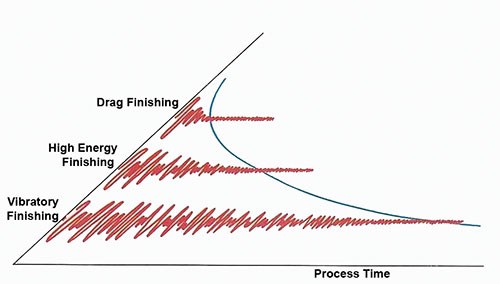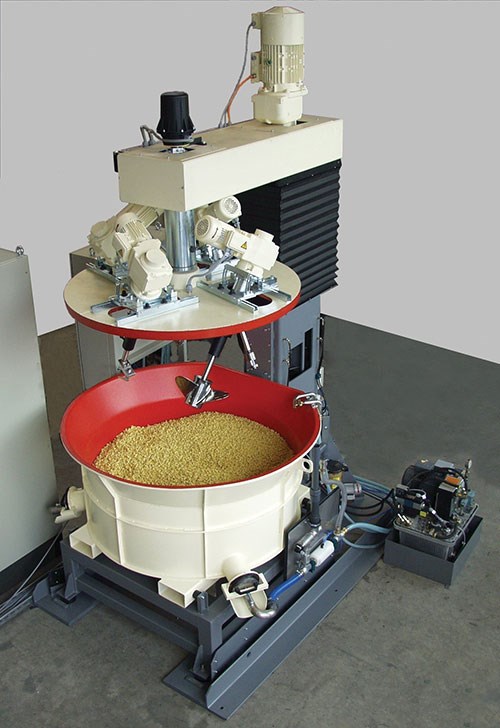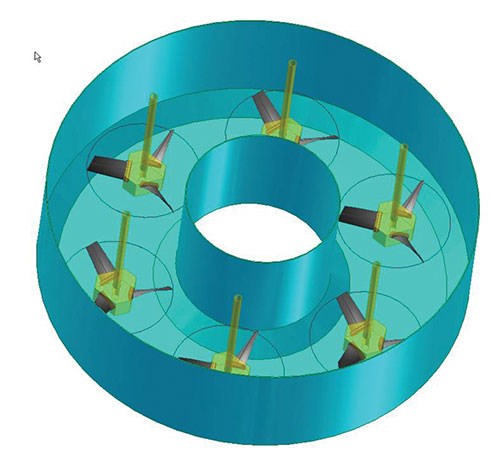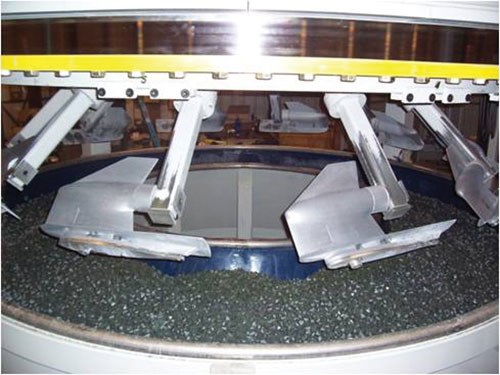Drag Finishing: Surface Finishing of Delicate Parts
For complex parts with high surface finish specs, production deburring and surface prep can be done using the Drag Finishing process.
Mechanical surface finishing, also known as mass finishing or vibratory finishing, is a technology that has been around for more than 6 decades. Its applications range from burr removal, putting a radius on sharp edges, and degreasing and de-rusting/de-scaling of metal parts all the way to high-gloss polishing of metal components. This technology is generally associated with vibratory tumblers, centrifugal barrels or centrifugal disk machines.
Usually, such finishing systems consist of a work bowl filled with a mix of grinding or polishing media and the parts that need to be finished. By way of vibration or centrifugal force, the mass of media and parts is put into motion. The constant “rubbing” of media on parts over a certain period of time—from a few minutes to several hours—is producing the desired surface finish.
In recent years, “drag finishing” has become a popular alternative for surface finishing of high value and somewhat delicate metal components. Like pushing a plow through the soil and, thus, polishing its blade, in drag finishing systems the parts mounted to a carousel—that in turn is equipped with multiple workstations—are “dragged” through a circular work bowl filled with grinding or polishing media.
Pressure and Speed
Mass finishing is all about pressure and speed. The higher the pressure exerted by the media on the parts, and the faster the media “rubs” on the parts, the faster the desired finishing results can be achieved. In this respect, drag finishing is standing out above other finishing methods: Because of the high speed at which the parts are dragged through the media and the high pressure generated, drag finishing works 40 times faster compared with vibratory systems and about 4 to 5 times faster than high energy systems. Frequently, because of its high speed and high pressure, drag finishing is the optimum mass finishing method to produce a satisfactory finish. This is especially true for parts made from hard-to-machine, “tough” metals like high-alloy steel (stainless, titanium, Inconel, and so on), tool steel or parts with a high surface hardness.
No Part-on-Part Contact
The outstanding characteristic of drag finishing is that the parts are individually mounted onto the workstations of the carousel. Depending on the machine size, the carousel is usually equipped with four to 12 workstations. Each workstation may be loaded with one or multiple parts.
Compared with conventional mass finishing systems where the parts are free-floating in the media, in drag finishing systems, the parts—being individually attached to the workstations—can never touch during the finishing process. This prevents part-on-part contact and, therefore, nicking or marring of the finish.
To individually mount the parts to the workstations requires special parts fixtures. Frequently, the design of these parts fixtures poses an engineering challenge. But the payoff is worth the effort because it produces consistent and totally repeatable surface finishes without the danger of the parts ever touching and, therefore, possibly nicking each other.
Aggressive Deburring to High-Gloss Polish
The applications for drag finishing range from aggressive deburring and edge breaking all the way to high gloss polish of a range of parts. Here are a few examples of successful drag finishing applications:
Grinding and polishing of stainless steel boat propellers: These are castings that undergo a drag grinding process in one machine followed by a polishing step in a second drag finisher.
Paint preparation of outboard marine drive
components: These are die castings that require
the removal of heat checks, breaking of sharp
edges and a homogeneous surface finish prior to painting.
Surface smoothing and polishing of turbine blades after machining and shot peening: This application reduces the surface roughness from Ra = 70 to Ra < 10 (1.8 micrometers to < 0.25 micrometers).
Grinding and polishing of medical implants such as artificial knees, hip stems, ankles, and so on: After casting, these parts are machined and then undergo a multi-stage drag finishing process for aggressive surface grinding, surface smoothing and high-gloss polishing.
There are many other successful drag finishing applications, but the scope of this article does not allow describing all of them.
Consistent, Repeatable, Economical Surface Finishes
Drag finishing is not a cheap surface finishing technology, but the technical and economic rewards far outweigh the cost.
These systems frequently replace manual deburring/grinding operations. Manual deburring/grinding is highly labor intensive, and it is difficult to find operators willing to perform this physically demanding and extremely noisy and dirty work. Above all, the quality of manual grinding depends entirely on the people doing the work and their physical and mental condition. For this reason, manual deburring/grinding usually produces a significant amount of rework or even scrap.
On the other hand, once a drag finishing process is locked in, it consistently produces the same high finishing quality day in and day out. By automating the finishing process, the human factor can be totally neutralized. With many drag finishing installations, the scrap/rework rate could be reduced to practically zero from sometimes double digit percentages.
In mass finishing systems, regardless of the part shape, the grinding or polishing media totally surround (envelop) the parts to be finished, reaching all surface areas. Naturally, this also applies to drag finishing. Especially in the medical implant industry, drag finishing systems have displaced robotic grinding and buffing systems. As versatile as robotic finishing systems may be, they are limited when it comes to reaching certain surface areas of parts with a complex geometry.
Of course, the most sophisticated drag finisher cannot produce satisfactory surface finishes if the right media is not available. Recent media developments with regard to their composition and abrasive contents have contributed to the success of drag finishing. For example, there is now media available that produces a pre-polish finish on parts from their “as cast” condition.
Tailor-Made to the Customer’s Requirements
Drag finishing systems are usually designed around the customers’ requirements. For this reason, there is a range of different types and sizes of drag finishing equipment available. Of crucial importance are the size and quantity of parts that need to be finished. Generally, the rule-of-thumb “the bigger the part, the bigger the machine” must be applied. Of course, the parts quantity also plays a big role. But just-in-time batch quantities may dictate that instead of one large drag finisher, a customer may want to install multiple small units.
At one extreme of the scale, there are so-called “mini drag” systems on the market with as many as four workstations and a bowl diameter of 40 to 50 inches. On the other side, there may be so-called “maxi drag” systems with ten to 12 workstations and a bowl diameter of more than 180 inches.
Of crucial importance is the fixturing of the parts to the workstations. These fixtures are always specially designed around the customers’ parts. Since many aspects such as degree of automation, wear protection, masking of certain parts areas, and so on, must be considered, the design process for the fixtures requires close communication between the customer and the supplier of the drag finishing system.
Whenever a manufacturer produces high value parts with a complex geometry, and these parts require a first-class surface finish (be it strictly functional or decorative), drag finishing is certainly a surface finishing technology worth considering.
Read Next
Do You Have Single Points of Failure?
Plans need to be in place before a catastrophic event occurs.
Read MoreA Tooling Workshop Worth a Visit
Marubeni Citizen-Cincom’s tooling and accessory workshop offers a chance to learn more about ancillary devices that can boost machining efficiency and capability.
Read MoreSeeing Automated Workpiece Measurement in Real Time
User-friendly inspection software for CNC machining centers was shown at IMTS 2024 monitoring measurements between and after machining while performing SPC based on recorded measurement values.
Read More
















.jpg;maxWidth=300;quality=90)





